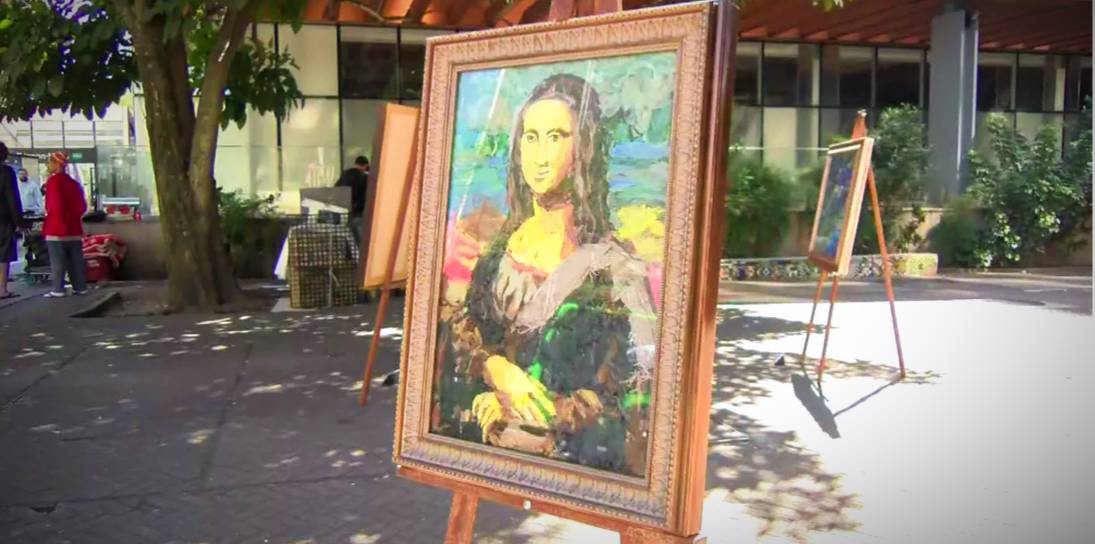Anúncios
Today we will talk about the Plastic Bag Mona Lisa. Art has the power to provoke deep reflections on our relationship with the environment. Eduardo Srur, a Brazilian artist and activist, transformed this reflection into a visual and sensory experience by recreating iconic works of art using plastic bags. With the theme “What legacy will we leave for the world?”, Srur brings a new perspective on the durability and environmental impact of plastic, in a project that has transformed São Paulo into an open-air museum.
The Art of Srur: Iconic Recreations with Plastic Bags

Eduardo Srur chose public domain works for his artistic intervention, recreating iconic pieces from art history with discarded plastic bags. Among the transformed works are Hokusai’s “The Great Wave off Kanagawa,” Leonardo da Vinci’s “Mona Lisa,” Paul Cézanne’s “Teapot and Fruit,” Edvard Munch’s “The Scream,” Vincent Van Gogh’s “The Starry Night,” and Claude Monet’s “Water Lilies.” By using plastic bags, Srur not only pays homage to these masterpieces, but also raises a crucial question: the durability of plastic and its environmental impact.
These creations have a greater purpose: to raise awareness about the incorrect use and disposal of plastic. Plastic, like these works of art, is incredibly durable, but unlike the works of art, the environmental impact of plastic is devastating. Srur wants society to reflect on the legacy we are leaving to the world and how our daily actions affect the environment.
Reflection on Environmental Legacy
The reflection proposed by Srur is profound and relevant. The artist highlights that, just as works of art have an impressive longevity, the plastic that we dispose of inappropriately also persists in the environment. “If these works of art have been around for over 100 years in the history of civilization, the plastic that you throw into nature will also be there. The ocean is the mother of all rivers, so the plastic that we throw on the streets of São Paulo will end up in our polluted metropolitan rivers that flow into the sea,” says Srur.
This contrast between the durability of the artworks and the persistence of plastic in the environment serves as a wake-up call to the urgent need to change our plastic consumption and disposal practices. Srur’s project is a call to action for all of us, reminding us that our choices have a lasting impact on the planet.
The Pollution Mobilization Project
Srur’s project was carried out in partnership with Corona beer and Parley for the Oceans, an organization dedicated to protecting the oceans and reducing plastic pollution. The collaboration resulted in an open-air museum in the Paulista area of São Paulo, where works of art made from plastic bags are on display. This installation not only beautifies the city, but also serves as a powerful means of mobilizing and raising awareness about plastic pollution.
Corona Beer and Parley for the Oceans play a crucial role in raising environmental awareness and fighting pollution. The project not only includes exhibiting the artwork, but also raising funds to support Pimp My Carroça, a movement that seeks to improve the visibility and income of waste pickers through art and collective participation.
The Social and Environmental Impact of the Works
The exhibition of Eduardo Srur’s works is not limited to an artistic event; it has a significant social impact. The proceeds from the auctioned works will go to Pimp My Carroça, an initiative that works to increase the visibility and income of recyclable material collectors. Since 2012, Pimp My Carroça has been dedicated to improving the working conditions of collectors and promoting recycling in a more efficient and dignified way.
This financial support is crucial to the movement, as it helps create opportunities for waste pickers and raises awareness about the importance of recycling. By integrating art and sustainability, Srur’s project not only offers a new perspective on the impact of plastic, but also contributes to an important social cause.
The Visual and Educational Experience
In addition to their function as art, Srur’s recreations also serve an educational purpose. The exhibition on Paulista allows the public to interact directly with the works and reflect on their message. Plastic bags, often seen as a disposable inconvenience, are transformed into something beautiful and meaningful, challenging the public to reconsider their value and impact.
The project offers a visual experience that is both aesthetically pleasing and intellectually stimulating. By linking the durability of plastic with the permanence of great works of art, Srur creates a powerful narrative about the need for change in our environmental practices.
How to Participate and Support the Cause
To learn more about the project and support the cause, you can visit the project’s official website. Here you will find additional information about the works, the initiative and how you can contribute to the fight against plastic pollution.
Participating and sharing the project’s message helps raise awareness and promote more sustainable practices. By supporting projects like Eduardo Srur’s, you contribute to creating a cleaner, more sustainable future, where art and environmental responsibility go hand in hand.
Eduardo Srur’s work is an inspiring example of how art can be used to spark change and promote environmental awareness. As we reflect on the legacy we leave behind, it is essential that we all do our part to protect the planet and create a more sustainable future for future generations. It was a pleasure to talk about the Mona Lisa made from Plastic Bags.
Check out other interesting facts about recycling clicking here.
Learn how to make art by recycling, Click here.




